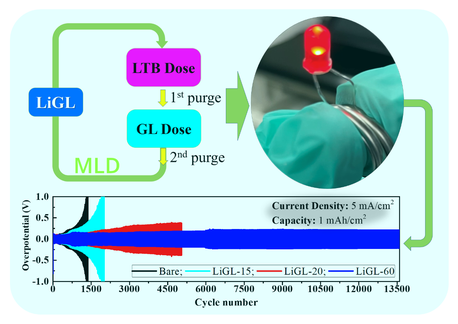At the University of Arkansas, scientists have come up with an innovative lithium-containing crosslinked polymeric material called LiGL (GL = glycerol). The new material could help tackle the two problems associated with commercializing Li metal anodes.
 Scientists from the University of Arkansas developed superior Li metal anodes for Li metal batteries using a novel LiGL polymeric coating. Image Credit: Xiangbo Meng, the University of Arkansas.
Scientists from the University of Arkansas developed superior Li metal anodes for Li metal batteries using a novel LiGL polymeric coating. Image Credit: Xiangbo Meng, the University of Arkansas.
This LiGL polymeric film displays remarkable properties and has the ability to efficiently safeguard Li metal anodes from SEI formation and dendritic growth to identify the long-term stable cyclability of Li electrodes. The researchers published their method in the Energy Material Advances journal on September 7th, 2021.
A range of technical approaches have been shown to mitigate the problems faced with Li anodes so far, like three-dimensional (3D) Li-hosting frameworks, solid-state electrolytes, electrolyte additives and surface coatings.
Among these efforts, surface coating remains as a facile and effective route. Molecular layer deposition (MLD) recently has emerged as a new research thrust, which is first practiced in 2018. These polymeric films, precisely synthesized via MLD, have much better flexibility over inorganic films, contributing to better protection effects and thereby better performance of Li metal anodes.
Xiangbo Meng, Study Corresponding Author and Professor, Department of Mechanical Engineering, University of Arkansas
Meng and his group have come up with three MLD processes of lithicones and investigated the protective impacts of such polymeric films coatings. They made attempts to identify long-term stable cyclability with a slight formation of SEI and Li dendrites for the Li electrodes.
In this work, we for the first time developed a novel lithium-containing crosslinked polymeric material, a lithicone that enables excellent protection effects over lithium (Li) metal anodes. We found that the LiGL lithicone could serve as an exceptional polymeric protection film over Li metal anodes.
Xiangbo Meng, Study Corresponding Author and Professor, Department of Mechanical Engineering, University of Arkansas
Meng feels that this LiGL MLD exhibits an acceptable average growth per cycle (GPC) of ~2.7 nm/cycle and demonstrates remarkable protection effects on Li electrodes, that is, exceptionally inhibiting Li dendrites and preventing SEI formation. The computational simulations and experiments showed that the MLD LiGL films are ionically conductive and electrically insulating.
The experimental data from this study shows that the Li electrodes coated with LiGL lithicone could realize excellent cycling stability, leading to an extremely long cyclability of >13,600 Li-stripping or plating cycles without failures in Li/Li symmetric cells at a 5 mA/cm2 current density and an areal capacity of 1 mAh/cm2.
The optimized outcomes have extended the cyclability to more than 20,000 Li-stripping/plating cycles (over 10,000 hours or more than a year) without failures. This is known to be the best cyclability reported to date. Thus, such outcomes have great promise and the MLD LiGL technology may have set the stage for a technical pathway for mitigating the problems of Li anodes.
The properties of the LiGL coatings, such as mechanical properties and conductivities, underlie their excellent protective effects on Li metal electrodes. This novel LiGL we developed represents a facile and effective solution to the existing issues of Li anodes and potentially paves a technically feasible route for lithium metal batteries.
Xiangbo Meng, Study Corresponding Author and Professor, Department of Mechanical Engineering, University of Arkansas
The contributors of the study include Xiangbo Meng, Sujan Kumar Ghosh, Mourad Benamara, and Min Zou from the University of Arkansas; Kah Chun Lau from California State University Northridge; and Hua Zhou from Argonne National Laboratory.
The study was financially supported by the Center for Advanced Surface Engineering, National Science Foundation Grant No. OIA-1457888 and the Arkansas EPSCoR Program, and the California State University Northridge and support from Cottrell Scholar Award (Award# 26829) by Research Corporation for Science Advancement (RCSA).
Journal Reference:
Meng, X., et al. (2021) Molecular Layer Deposition of Crosslinked Polymeric Lithicone for Superior Lithium Metal Anodes. Energy Material Advances. doi.org/10.34133/2021/9786201.